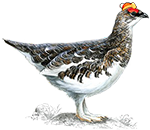|
Hey all, I have spent many years working with museum collections. My background is in entomology, but I have worked with all kinds of zoological collections, mostly as a curator and technician. I recently left the museum collections, but it's an interesting world. Things I have done:
Ask me stuff and I will try my best to answer! 
axolotl farmer fucked around with this message at 21:35 on Oct 13, 2021 |
|
|
|

|
| # ? Apr 20, 2024 01:35 |
|
What were the rivalries and cliques? Where the dinosaur people the cool kids in the lunch room? Did you ever set up displays to try and scare children?
|
|
|
|
Did you ever touch something without gloves when no one was looking that you weren't supposed to? Probably more applicable to something rare/historical than something stinky and gross, but who knows.
|
|
|
|
Whatís the biggest bug youíve ever mounted Thats what she said!!!!
|
|
|
|
Did you ever raise insects from eggs in order to pin them?
|
|
|
|
How much schooling did you get for this job, if you don't mind my asking? I almost went into collections managment myself but was afraid of being in college forever doing a masters or phd degree in order to maybe get hired for it. I've always wondered if I got the wrong impression about this.
|
|
|
|
Random Stranger posted:What were the rivalries and cliques? Where the dinosaur people the cool kids in the lunch room? Did you ever set up displays to try and scare children? No real rivalries, except maybe science vs. admin, but you get that at every place in academia. The paleo people have their own building, so I rarely saw them at lunch. Most departments had their own lunch room, but the entomology lunch room was the fun one, that's where you went if you wanted to talk and hang out. People came there from other departments quite often just because it was a nice place. I never worked on exhibitions, so I never had the opportunity to scare children. MayakovskyMarmite posted:Did you ever touch something without gloves when no one was looking that you weren't supposed to? Probably more applicable to something rare/historical than something stinky and gross, but who knows. I only wore gloves when working with vertebrate collections, like pelts, mounts and bird skins. I did an inspection for pests in the mammal pelt collection, and that was with gloves, lab coat and N95 mask. The reason for all the safety gear is that they used to use a lot of toxic stuff when preserving pelts until quite recently. You never know which one is full of mercury or arsenic. The one thing I touched that I remember was a snow leopard pelt. It was incredibly soft Pablo Nergigante posted:Whatís the biggest bug youíve ever mounted Thats what she said!!!! Probably a large hawker dragonfly, if you go by wing span. Or an Eastern Hercules beetle, if you go by "drat, that's a huge bug!". axolotl farmer fucked around with this message at 08:18 on Oct 14, 2021 |
|
|
|
Pteretis posted:Did you ever raise insects from eggs in order to pin them? For a while I had a live pet mantis on my desk, and I pinned it after it died. My co-worker brought an ooetheca (egg sack) back from field work and lots and lots of little mantises hatched from it. Lepidopterists (butterflies and moths) do this a bit more. They see a plant that has traces of a leaf miner moth, and bring it in to try an hatch the moth itself.  Modern museum collections are working scientific collections, so pretty much nothing is collected because it's impressive or even because it's pretty. Insects are collected either because they are poorly known, or as documentation about distribution and habitat. We had a couple of terraria with live insects in the lunch room, but that was mostly for showing visitors and because they looked pretty. There were stick insects, hissing cockroaches, assasin bugs and a Mexican red-knee tarantula (not an insect) that had been there since it was a hatchling in the 1990s. Since they weren't collected from the wild, they had no scientific value. And that's pretty much the only thing that counts if you have to decide to include it in the collections or not. People often want to donate their private insect collections to the museum, and what was important was if it was documented or not. If specimens were labeled with collection data (time, place, collector), then it could go into the collections. If it was mounted and framed impressive butterflies and moths bought as a souvenir, it's not interersting for the collections.
|
|
|
|
Turbinosamente posted:How much schooling did you get for this job, if you don't mind my asking? I almost went into collections managment myself but was afraid of being in college forever doing a masters or phd degree in order to maybe get hired for it. I've always wondered if I got the wrong impression about this. I have a PhD in systematic zoology. I started working with collections because I needed a job, and I liked the museum and knew lots of people there. The pay is really bad, and everyone has gone to grad school and got burned out an being a scientist and the whole hellworld that is academia.
|
|
|
|
What's the most exotic insect you've seen someone raise?
|
|
|
|
LibrarianCroaker posted:What's the most exotic insect you've seen someone raise? I don't really know much about rearing insects in terraria, but I know that breeders have cracked how to breed asian hercules beetles full cycle in captivity.
|
|
|
|
Do you find people are put off/your field lacks numbers compared to the others or is there a healthy supply of bug fanciers? And are there many insects types in the collections that are no longer available today? I know a lot is said about bees and butterflies disappearing but you never really hear much about others.
|
|
|
|
Have you ever been around for when somebody opens a storage box or drawer that hasn't been looked at in decades and realized that there is something that was previously unknown in it?
|
|
|
|
Sentinel Red posted:Do you find people are put off/your field lacks numbers compared to the others or is there a healthy supply of bug fanciers? And are there many insects types in the collections that are no longer available today? I know a lot is said about bees and butterflies disappearing but you never really hear much about others. I would say itís a renewed interest in insects and entomology. Itís part because of the news stories and books about the loss of bees an other pollinators, but cellphones have really changed the publicís view of insects. Since everyone carries around a decent camera, they see a weird bug and can post about it in an insect fb group and get an answer. There are so many unknown bugs in collections all over the world. More new species are described from museum collections than from discoveries in the field. When entomologist collect insect, they mostly collect with traps, and get a lot of bycatch along with the groups they are interested in. The bycatch is usually deposited in the collections, roughly sorted to order or family, but can sit there until an expert takes a look and realizes that there is undescribed stuff in there.
|
|
|
|
GATOS Y VATOS posted:Have you ever been around for when somebody opens a storage box or drawer that hasn't been looked at in decades and realized that there is something that was previously unknown in it? Many times when a guest researcher or visiting expert comes by. There are so many discoveries to be made in museum collections! In every collection there are lots of unidentified and misidentified specimens, and thatís where lots of species that are new to science are discovered.
|
|
|
|
axolotl farmer posted:I have a PhD in systematic zoology. I started working with collections because I needed a job, and I liked the museum and knew lots of people there. This rather lines up with what I've heard, unfortunately. At least I got to tour some of the storage at local museums when I did do a museum studies minor at college, that was always fun. Here's an oddball question that you sorta touched on earlier, did you get stuck doing all the pest control countermeasures because you're the entomologist? Did you have any disasters with live bugs invading and eating the dead stuff in the natural collections? I remember learning about that possiblity in school, and that as part of preventing it the local science museum had sticky traps around and it was someone's job to check them regularly and note the amount, type, and direction of bugs in the trap as a sort of early warning system.
|
|
|
|
Did you manage any collections which you thought could have been really important but just sat there gathering dust? As a counterpart to that, do you think researchers have a good idea of what collections are actually out there and available to be exploited?
|
|
|
|
Turbinosamente posted:This rather lines up with what I've heard, unfortunately. At least I got to tour some of the storage at local museums when I did do a museum studies minor at college, that was always fun. Everyone at the department for zoology got a quota of pest control, even the senior staff. Every drawer and cabinet was checked at least once a year. There used to be a lot of poisons around the collections. Pelts were treated with arsenic and mercury, and the insect collection was gassed with dichlorvose from time to time. Poison was phased out in the 1980s, and so the pests came back. It's kept in check by the monitoring, and you never see one of those drawers that are completely destroyed anyomor. You see a small pile of dust (actually carpet beetle poop) under a pinned insect, a carpet beetle larval skin, or even a live larvae. Then you make a note of where it was, and the whole drawer goes into the freezer. After a week in the freezer, any trace of the pests are clean up so the next one inspecting the drawer this it's an ongoing infestation. The situation in the osteological collections is something else, though. They don't really see carpet beetles as pests, as they actually clean any remaining tissue off the bones. We were instructed to avoid going into other parts of the collections if we had been working in the bone collections. I had a lot of opions about how they were run. And carpet beetle poop and larval skins are a health hazard. Many older curators develop allergies and contact dermatitis from it. Bleh. This is the humble unit box, something that revolutionized entomological collections. It wasn't until the 1980s that entomological collections started getting moved into these. There are still a lot of drawers without any kinds of divisions.  Putting unit boxes into a drawer has all kinds of advantages. The pests at least have an obstacle between specimens. If a specimen comes loose, it's not going to roll around the [i]entire drawer and destroy stuff. It's weired that entomological collections looked pretty much the same (glass-top drawers in a cabinet) since the 1700s until these were invented. 
|
|
|
|
goatface posted:Did you manage any collections which you thought could have been really important but just sat there gathering dust? There is so much unprocessed material in every museum. Trap catches, stuff that was collected and never looked through. Mostly it's sitting there, but so much of it is undocumented, even when collections are getting digitized more and more. Sorting trap catches is a lot of work, and every museum is understaffed, so the material goes unsorted. At the end each group in a collection, therer are drawers full of unsorted or unidentified stuff. What you can hope for is that a visiting scientist decides to take a look and go through it. Usually they just pick out the specimens from their own very specialized interest group, but at least it's a start. I would like for museums to document the unprocessed material more. There are no resources to identifiy it all by themselves, but on the level of "we got five drawers of unidentified weevils from SE Asia in this collection, and three more from East Africa"
|
|
|
|
what's the rarest bug you've handled? and what's the most dangerous (live) one?
|
|
|
|
Davincie posted:what's the rarest bug you've handled? and what's the most dangerous (live) one? There are many species of insects that are only known from a single, or very few specimens collected at a single collection event. No one really knows if they are rare, or just rarely collected. If they were collected from a place that used to be forest, but is now farmland or city, that species is very likely extinct. I have handled old specimens of Thyreophora cynophila. This weird fly with a blue body and orange head was only known from sixteen museum specimens, all collected in Europe before 1840. My museum had two of those specimens, collected in Germany in the early 1800s. It was the only fly considered to be extinct. To everyone's surprise, the species was rediscovered in 2009, in a forest in Spain.  This fly is a specialist, it breeds in the marrow of crushed bones from large carcasses. There are pretty much no large carcasses lying around anymore. Cattle are disposed of, forests are managed and there are few large predators like wolves around to leave large crushed bones lying around. This fly was described from the carcass of a dog in 1798. It was rediscovered in a protected forest, at high altitude. Turned out it was not common there, but hanging on. There are probably more small populations in the less populated and forested regions of Europe. I have also handled lots of type specimens, the individuals that were used to describe a species.  This is one of the oldest specimens in all known insect collections. The type specimen for the Mottled Umber moth, Erannis defoliaria. This is int the collections of Clerck, and was collected and pinned in the mid 1700s. You can see the original drawer in the background. I took this pic when I entered the details of that specimen in the museum database.
|
|
|
|
Forgot about the most dangerous one! It's a boring answer, but probably a mosquito with the potential of carrying malaria, or a regular yellowjacket that can put an allergic person into anaphylactic shock. Oh, a long time ago I was helping a scientist unpack a large box of live scorpions. They were all packages in plastic food containers, like flimsy clear plastic boxes that you get salad in. They were taped shut, but one of the boxes had come open in transit and was empty. We went along slowly with the unpacking, and the loose scorpion was found hiding at the bottom of the box.
|
|
|
|
do the bone people ever call you bug chasers
|
|
|
|
ChubbyChecker posted:do the bone people ever call you bug chasers No
|
|
|
|
do you get to name new bugs
|
|
|
|
ChubbyChecker posted:do you get to name new bugs If you discover something that's not yet described and publish a description in a scientific journal. There are undescribed species everywhere, if you put up an insect trap pretty much anywhere on land that's not a mountain peak or arctic ice you will collected undescribed flies and midges. The hard part is actually knowing if a specimen belongs to a species that's already been described. Take Phorids. You pretty much can't put up an insect trap without getting Phorids, they're tiny flies that mostly breed in decaying stuff like dead animals, rotten fungi and animal crap. They are everywhere and they are extremely hard to tell apart. Say you put up a trap and collect 100s of Phorid flies. To get to describe a new species from that trap, you need to sort and identify every single specimen, compare them to the already described ones, and when one doesn't match, you get to describe and name the new species. There are rules for naming species, and naming something after yourself is considered bad form.
|
|
|
|
axolotl farmer posted:If you discover something that's not yet described and publish a description in a scientific journal. have you named any
|
|
|
|
What's a normal day in the life of a museum collections person? Pest control, sorting collections, writing papers? Do you have any stories of exciting times at work? Entomological emergencies you've been involved in?
|
|
|
|
ChubbyChecker posted:have you named any When I was doing research it was more about phylogenetics and bioinformatics, and I was working with a taxonomically well known group. So no, not yet. I do have a species name after me. A tiny parasite wasp that was found in a trap that I had set up. There were several new species described from that trap, and each person in the expedition got a species named after them. I don't think "my species" will be found again anytime soon.
|
|
|
|
axolotl farmer posted:When I was doing research it was more about phylogenetics and bioinformatics, and I was working with a taxonomically well known group. haha, nice
|
|
|
axolotl farmer posted:
I imagine that's doused in some of those harsh chemicals in order to keep it from turning into dust? How have those chemicals changed over the years? Is there a situation like with varnish in old paintings, where the original formulations (rabbit skin glue, natural resins, etc) deteriorate, discolour, or otherwise need to be addressed and updated? Fun thread! 
|
|
|
|
|
Nosre posted:I imagine that's doused in some of those harsh chemicals in order to keep it from turning into dust? How have those chemicals changed over the years? Is there a situation like with varnish in old paintings, where the original formulations (rabbit skin glue, natural resins, etc) deteriorate, discolour, or otherwise need to be addressed and updated? and what are butterflies' wings made of
|
|
|
|
Do you have drawers full of maggots on pins to go with the adults?
|
|
|
|
big scary monsters posted:What's a normal day in the life of a museum collections person? Pest control, sorting collections, writing papers? The scientists payed to do science spend half their time writing papers and half the time writing grants to get funding for their resarch. On top of that they have to do the actualy research and tutor grad students. I worked mostly as a curator and technician. I did a lot of interpreting labels and entering specimen information into a database. For most of it, a literate chimp could do it, but once in a while you actually need to know something about taxonomy and the history of the collections. There was also the general care of the collections, if you saw that the alcohol in a jar had started to evaporate, you either topped it off and closed the jar again, or got a new better jar and threw the old one away. They used to seal the jars really well, which is great until it isn't. Everyone working with wet collections has stood there banging the lid of an ancient jar with a ground glass seal against the sink. Now we mostly use regular cheap screwtop jars, ordered from a supplier that mostly sells to food factories. The jars are cheap, easy to open and very replacable. Not many exciting stories, but odd ones. Helping to move a very old, rock hard giraffe pelt through a very narrow spiral staircase for example.
|
|
|
|
Nosre posted:I imagine that's doused in some of those harsh chemicals in order to keep it from turning into dust? How have those chemicals changed over the years? Is there a situation like with varnish in old paintings, where the original formulations (rabbit skin glue, natural resins, etc) deteriorate, discolour, or otherwise need to be addressed and updated? In this cabinet, the original 1700s one, the drawers are painted on the inside with a green pigment. I suspect there is toxic copper salts involved. It also reeks of mothballs. We don't used poisons at all anymore, for lots of reasons, but mostly for the safety of the workers. A pinned insect will remain in good condition for hundreds of years as long as it is kept away from light and pests. There are cases where large insects with lots of fat in them will cause a pin to corrode and form long strands of green verdigris.  The pin can be corroded through, and there are metods to replace them. The specimens and materials that have kept the best use very simple materials. A label written in pencil on acid free paper will last forever. Specimens stored in alcohol look the same 300 years later.
|
|
|
|
ChubbyChecker posted:and what are butterflies' wings made of Chitin goatface posted:Do you have drawers full of maggots on pins to go with the adults? Maggots shrivel when they dry up. Maggots in the collection is usually preserved in alcohol.
|
|
|
|

|
| # ? Apr 20, 2024 01:35 |
|
axolotl farmer posted:For most of it, a literate chimp could do it Also, do you actually farm axolotls? Because that would be an equally interesting thread.
|
|
|



























